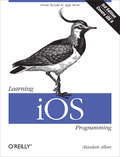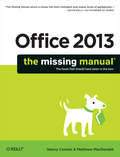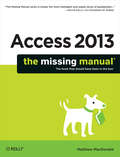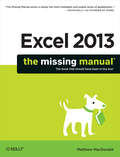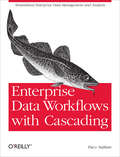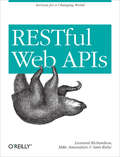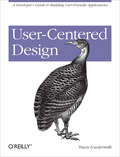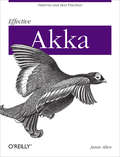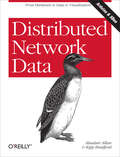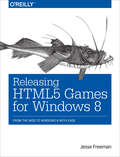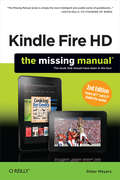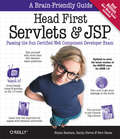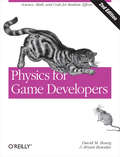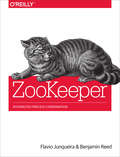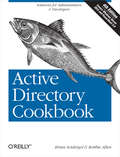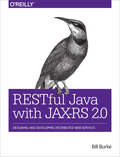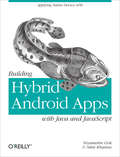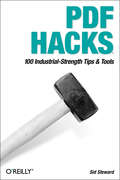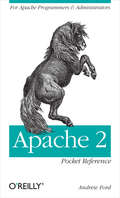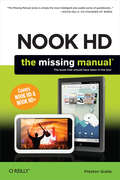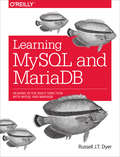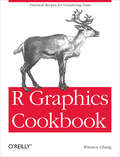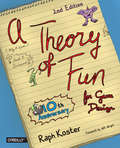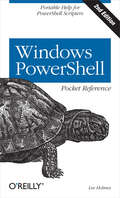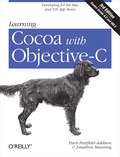- Table View
- List View
Learning iOS Programming: From Xcode to App Store
by Alasdair AllanGet a rapid introduction to iPhone, iPad, and iPod touch programming. With this easy-to-follow guide, you'll learn the steps necessary for developing your first marketable iOS application, from opening Xcode to submitting your product to the App Store. Whether you're a developer new to Mac programming or an experienced Mac developer ready to tackle iOS, this is your book. You'll learn about Objective-C and the core frameworks hands-on by writing iOS applications that use them, giving you the basic skills for building your own applications independently. Packed with code samples, this book is refreshed and updated for iOS 5 and Xcode 4. Discover the advantages of building native iOS apps Get started with Objective-C and the Cocoa Touch frameworks Dive deep into the table view classes for building user interfaces Handle data input, parse XML and JSON documents, and store data on SQLite Use iOS sensors, including the accelerometer, magnetometer, camera, and GPS Build apps that use the Core Location and MapKit frameworks Integrate Apple's iCloud service into your applications
Office 2010: The Missing Manual (The\missing Manual Ser.)
by Matthew Macdonald Nancy ConnerMicrosoft Office is the most widely used software suite in the world. The half-dozen programs in Office 2010 are packed with amazing features, but most people just know the basics. This entertaining guide not only gets you started with Office, it reveals all kinds of useful things you didn't know the software could do -- with plenty of power-user tips and tricks when you're ready for more. Create professional-looking documents. Learn everything you need to know to craft beautiful Word documents. Stay organized. Keep track of your email, calendar, and contacts with Outlook. Crunch numbers with ease. Assemble data, make calculations, and summarize the results with Excel. Make eye-catching presentations. Build PowerPoint slideshows with video and audio clips, animations, and more. Build Access databases quickly. Make your data easy to find, sort, and manage. Manage your files more efficiently. Use the new Backstage view to quickly work with your Office files. Get to know the whole suite. Learn to use other handy Office tools: Publisher, OneNote, and Office Web Apps.
Access 2007: The Missing Manual (The\missing Manual Ser.)
by Matthew MacdonaldCompared to industrial-strength database products such as Microsoft's SQL Server, Access is a breeze to use. It runs on PCs rather than servers and is ideal for small- to mid-sized businesses and households. But Access is still intimidating to learn. It doesn't help that each new version crammed in yet another set of features; so many, in fact, that even the pros don't know where to find them all. Access 2007 breaks this pattern with some of the most dramatic changes users have seen since Office 95. Most obvious is the thoroughly redesigned user interface, with its tabbed toolbar (or "Ribbon") that makes features easy to locate and use. The features list also includes several long-awaited changes. One thing that hasn't improved is Microsoft's documentation. To learn the ins and outs of all the features in Access 2007, Microsoft merely offers online help. Access 2007: The Missing Manual was written from the ground up for this redesigned application. You will learn how to design complete databases, maintain them, search for valuable nuggets of information, and build attractive forms for quick-and-easy data entry. You'll even delve into the black art of Access programming (including macros and Visual Basic), and pick up valuable tricks and techniques to automate common tasks -- even if you've never touched a line of code before. You will also learn all about the new prebuilt databases you can customize to fit your needs, and how the new complex data feature will simplify your life. With plenty of downloadable examples, this objective and witty book will turn an Access neophyte into a true master.
Excel 2007: The Missing Manual (The\missing Manual Ser.)
by Matthew MacdonaldMicrosoft Excel continues to grow in power, sophistication, and capability, but one thing that has changed very little since the early '90s is its user interface. The once-simple toolbar has been packed with so many features over the years that few users know where to find them all. Microsoft has addressed this problem in Excel 2007 by radically redesigning the user interface with a tabbed toolbar that makes every feature easy to locate and use. Unfortunately, Microsoft's documentation is as scant as ever, so even if users can find advanced features, they probably won't know what to do with them. Excel 2007: The Missing Manual covers the entire gamut of how to build spreadsheets, add and format information, print reports, create charts and graphics, and use basic formulas and functions. Like its siblings in the Missing Manual series, this book crackles with a fine sense of humor and refreshing objectivity about its subject, guiding readers through the new Excel with clear explanations, step-by-step instructions, lots of illustrations, and friendly, time-saving advice. It's a perfect primer for small businesses with no techie to turn to, as well as those who want to organize household and office information.
Enterprise Data Workflows with Cascading: Streamlined Enterprise Data Management and Analysis
by Paco NathanDespite its growing use in the enterprise, building applications for Hadoop is notoriously difficult. But there is a solution. This hands-on book introduces you to Cascading, the framework that enables you to build powerful data processing applications on Hadoop without having to spend months learning the intricacies of MapReduce. Whether you're a developer, data scientist, or system/IT administrator, you'll quickly learn Cascading's streamlined approach to data processing, data filtering, and workflow optimization, using sample apps based on Java, Scala, and Clojure. Companies such as Etsy, Razorfish, TeleNav, and Twitter already use Cascading for mission-critical applications. This book shows you how this framework can help your organization extract meaningful information from large amounts of distributed data. Examine best practices for using data science in enterprise-scale apps Learn how to use workflows that reach beyond MapReduce to integrate other popular Big Data frameworks Quickly build and test applications with familiar constructs and reusable components, and instantly deploy them onto large clusters Easily discover, model, and analyze both unstructured and semi-structured data in any format and from any source Seamlessly move and scale application deployments from development to production, regardless of cluster location or data size
RESTful Web APIs: Services for a Changing World
by Leonard Richardson Sam Ruby Mike AmundsenRESTful APIs make programming easy for users, but it can be tricky to map traditional APIs to REST expectations. While REST simplifies user expectations, getting the flow and granularity of data right remains a challenge. REST's popularity has led to tremendous growth in "almost REST" APIs, and grown demand for projects that evolve toward the hypermedia possibilities REST opens for data on the Web. This book shows readers how to get APIs as close as possible to optimum usability, focusing on solutions to common problems that cross a variety of domains. By combining the tools and expectations that the Web has already provided with complex data structures, developers will be able to create secure and powerful applications their customers will be happy to use.
User-Centered Design: A Developer's Guide to Building User-Friendly Applications
by Travis LowdermilkHow do you design engaging applications that people love to use? This book demonstrates several ways to include valuable input from potential clients and customers throughout the process. With practical guidelines and insights from his own experience, author Travis Lowdermilk shows you how usability and user-centered design will dramatically change the way people interact with your application. Learn valuable strategies for conducting each stage of the design process--from interviewing likely users and discovering your application's purpose to creating a rich user experience with sound design principles. User-Centered Design is invaluable no matter what platform you use or audience you target. Explore usability and how it relates to user-centered design Learn how to deal with users and their unique personalities Clarify your application's purpose, using a simple narrative to describe its use Plan your project's development with a software development life cycle Be creative within the context of your user experience goals Use visibility, consistency, and other design principles to enhance user experience Collect valuable user feedback on your prototype with surveys, interviews, and usability studies
Effective Akka: Patterns and Best Practices
by Jamie AllenThis book will explain how to create Akka applications using best practices based on several years of experience with Actors. The content will be general enough that it would apply to actor-based and asynchronous applications on the whole, but the examples are shown in Akka using the Scala programming interface. The ideal audience are developers who are building systems with Akka and are looking for guidance with regards to patterns and how best to write code that is correct, debuggable and understandable in production.
Distributed Network Data: From Hardware to Data to Visualization
by Alasdair Allan Kipp BradfordBuild your own distributed sensor network to collect, analyze, and visualize real-time data about our human environment--including noise level, temperature, and people flow. With this hands-on book, you'll learn how to turn your project idea into working hardware, using the easy-to-learn Arduino microcontroller and off-the-shelf sensors. Authors Alasdair Allan and Kipp Bradford walk you through the entire process, from prototyping a simple sensor node to performing real-time analysis on data captured by a deployed multi-sensor network. Demonstrated at recent O'Reilly Strata Conferences, the future of distributed data is already here. If you have programming experience, you can get started immediately. Wire up a circuit on a breadboard, and use the Arduino to read values from a sensor Add a microphone and infrared motion detector to your circuit Move from breadboard to prototype with Fritzing, a program that converts your circuit design into a graphical representation Simplify your design: learn use cases and limitations for using Arduino pins for power and grounding Build wireless networks with XBee radios and request data from multiple sensor platforms Visualize data from your sensor network with Processing or LabVIEW
Releasing HTML5 Games for Windows 8: From the Web to Windows 8 with Ease
by Jesse FreemanWindows 8 presents an incredible opportunity for distributing and monetizing HTML5 games, and this guide shows how you can profit from it. You'll learn everything you need to know about porting your original web-based JavaScript game to the new "touch-first" version of Windows, as well as several options for selling your game in Windows Store. Windows 8 is a big leap forward for developers because it treats HTML5 as a first-class citizen, alongside C# and C++. Interactive development expert Jesse Freeman explains how Windows 8 works, gets you started with Visual Studio Express (it's free!), and uses a case study to show you how to port an HTML5 game with ease. Learn which games and JavaScript libraries work best on Windows 8 Adjust artwork for different screen resolutions and Windows 8 features Accommodate mouse, keyboard, touch, and other game controls Optimize your game to run well on any Windows 8 device Understand the steps for publishing your game to Windows Store Explore fixed price, trial mode, ad support, and in-app purchase options Use a web-first workflow to ensure your game runs on many other platforms
Kindle Fire HD: The Missing Manual Second Edition
by Peter Meyers<p>Amazon’s Kindle Fire HD combines the most popular e-reader and tablet features in one sleek package, and with this entertaining guide, you’ll master everything the Fire has to offer. With loads of illustrations, step-by-step instructions, and savvy tips, you’ll learn how to manage your media library in the cloud, find the coolest apps, and make the most of your Kindle Fire experience—no matter which model you choose.</p>
Head First Servlets and JSP: Passing the Sun Certified Web Component Developer Exam (Head First)
by Bryan Basham Bert Bates Kathy SierraImagine a world without eBay... unthinkable! How would you get that Farrah Fawcett poster, retired Beanie Baby, or first-edition pet rock? Handling over a gazillion (OK, we exaggerate--it's actually only 1 billion) page views each day, server-side Java makes eBay work. Isn't it time you learned the latest (J2EE 1.4) versions of Servlets and JSPs? This book will get you way up to speed on the technology you'll know it so well, in fact, that you can pass the Sun Certified Web Component Developer (SCWCD) 1.4 exam. If that's what you want to do, that is. Maybe you don't care about the exam, but need to use Servlets and JSPs in your next project. You're working on a deadline. You're over the legal limit for caffeine. You can't waste your time with a book that makes sense only AFTER you're an expert (or worse one that puts you to sleep). No problem. Head First Servlets and JSP's brain-friendly approach drives the knowledge straight into your head (without sharp instruments). You'll interact with servlets and JSPs in ways that help you learn quickly and deeply. It may not be The Da Vinci Code, but quickly see why so many reviewers call it "a page turner". Most importantly, this book will help you use what you learn. It won't get you through the exam only to have you forget everything the next day. Learn to write servlets and JSPs, what makes the Container tick (and what ticks it off), how to use the new JSP Expression Language (EL), what you should NOT write in a JSP, how to write deployment descriptors, secure applications, and even use some server-side design patterns. Can't talk about Struts at a cocktail party? That'll change. You won't just pass the exam, you will truly understand this stuff, and you'll be able to put it to work right away. This new exam is tough--much tougher than the previous version of the SCWCD. The authors of Head First Servlets and JSP know: they created it. (Not that it EVER occurred to them that if they made the exam really hard you'd have to buy a study guide to pass it.) The least they could do is give you a stimulating, fun way to pass the thing. If you're one of the thousands who used Head First EJB to pass the SCWCD exam, you know what to expect!<P> Advisory: Bookshare has learned that this book offers only partial accessibility. We have kept it in the collection because it is useful for some of our members. To explore further access options with us, please contact us through the Book Quality link on the right sidebar. Benetech is actively working on projects to improve accessibility issues such as these.
Physics for Game Developers: Science, math, and code for realistic effects
by David M Bourg Bryan BywalecIf you want to enrich your game's experience with physics-based realism, the expanded edition of this classic book details physics principles applicable to game development. You'll learn about collisions, explosions, sound, projectiles, and other effects used in games on Wii, PlayStation, Xbox, smartphones, and tablets. You'll also get a handle on how to take advantage of various sensors such as accelerometers and optical tracking devices. Authors David Bourg and Bryan Bywalec show you how to develop your own solutions to a variety of problems by providing technical background, formulas, and a few code examples. This updated book is indispensable whether you work alone or as part of a team. Refresh your knowledge of classical mechanics, including kinematics, force, kinetics, and collision response Explore rigid body dynamics, using real-time 2D and 3D simulations to handle rotation and inertia Apply concepts to real-world problems: model the behavior of boats, airplanes, cars, and sports balls Enhance your games with digital physics, using accelerometers, touch screens, GPS, optical tracking devices, and 3D displays Capture 3D sound effects with the OpenAL audio API
ZooKeeper: Distributed Process Coordination
by Flavio Junqueira Benjamin ReedBuilding distributed applications is difficult enough without having to coordinate the actions that make them work. This practical guide shows how Apache ZooKeeper helps you manage distributed systems, so you can focus mainly on application logic. Even with ZooKeeper, implementing coordination tasks is not trivial, but this book provides good practices to give you a head start, and points out caveats that developers and administrators alike need to watch for along the way. In three separate sections, ZooKeeper contributors Flavio Junqueira and Benjamin Reed introduce the principles of distributed systems, provide ZooKeeper programming techniques, and include the information you need to administer this server. Learn how ZooKeeper solves common coordination tasks Explore the ZooKeeper API's Java and C implementations and how they differ Use methods to track and react to ZooKeeper state changes Handle failures of the network, application processes, and ZooKeeper itself Learn about ZooKeeper's trickier aspects dealing with concurrency, ordering, and configuration Use the Curator high-level interface for connection management Become familiar with ZooKeeper internals and administration tools
Active Directory Cookbook: Solutions for Administrators & Developers (Cookbooks (o'reilly) Ser.)
by Robbie Allen Brian SvidergolWhen you need practical hands-on support for Active Directory, the updated edition of this extremely popular Cookbook provides quick solutions to 450 common (and uncommon) problems you might encounter when deploying, administering, and automating Microsoft's network directory service. Updated for Windows Server 2012, Windows 8, and Exchange 2013, the fourth edition offers troubleshooting recipes based on valuable input from Windows administrators. You'll find solutions for the Lightweight Directory Access Protocol (LDAP), AD LDS (Active Directory Lightweight Directory Services), multi-master replication, Domain Name System (DNS), Group Policy, the Active Directory Schema, and many other features. The Active Directory Cookbook will help you: Perform Active Directory tasks from the command line Use PowerShell to automate Active Directory tasks Manage new Active Directory features, such as the Active Directory Recycle Bin, Group Managed Service Accounts, fine-grained password policies, and more Create domains and trusts Locate users whose passwords are about to expire Apply a security filter to group policy objects Check for potential replication problems Restrict hosts from performing LDAP queries View DNS server performance statistics
RESTful Java with JAX-RS 2.0: Designing and Developing Distributed Web Services
by Bill Burke<p>Learn how to design and develop distributed web services in Java, using RESTful architectural principles and the JAX-RS 2.0 specification in Java EE 7. By focusing on implementation rather than theory, this hands-on reference demonstrates how easy it is to get started with services based on the REST architecture.</p>
Building Hybrid Android Apps with Java and JavaScript: Applying Native Device APIs
by Nizamettin Gok Nitin KhannaBuild HTML5-based hybrid applications for Android with a mix of native Java and JavaScript components, without using third-party libraries and wrappers such as PhoneGap or Titanium. This concise, hands-on book takes you through the entire process, from setting up your development environment to deploying your product to an app store. Learn how to create apps that have access to native APIs, such as location, vibrator, sensors, and the camera, using a JavaScript/Java bridge--and choose the language that gives you better performance for each task. If you have experience with HTML5 and JavaScript, you'll quickly discover why hybrid app development is the wave of the future. Set up a development environment with HTML, CSS, and JavaScript tools Create your first hybrid Android project, using Eclipse IDE Use the WebView control to host your hybrid application Explore hybrid application architecture, including JavaScript/Java communication Build single-page applications, using JavaScript libraries such as Backbone and Underscore Get optimization tips and useful snippets for CSS, DOM, and JavaScript Distribute your application to Google Play and the Amazon Appstore
PDF Hacks: 100 Industrial-Strength Tips & Tools
by Sid StewardPDF--to most of the world it stands for that rather tiresome format used for documents downloaded from the web. Slow to load and slower to print, hopelessly unsearchable, and all but impossible to cut and paste from, the Portable Document Format doesn't inspire much affection in the average user. But PDFs done right is another story. Those who know the ins and outs of this format know that it can be much more than electronic paper. Flexible, compact, interactive, and even searchable, PDF is the ideal way to present content across multiple platforms. PDF Hacks unveils the true promise of Portable Document Format, going way beyond the usual PDF as paged output mechanism. PDF expert Sid Steward draws from his years of analyzing, extending, authoring, and embellishing PDF documents to present 100 clever hacks--tools, tips, quick-and-dirty or not-so-obvious solutions to common problems. PDF Hacks will show you how to create PDF documents that are far more powerful than simple representations of paper pages. The hacks in the book cover the full range of PDF functionality, from the simple to the more complex, including generating, manipulating, annotating, and consuming PDF information. You'll learn how to manage content in PDF, navigate it, and reuse it as necessary. Far more than another guide to Adobe Acrobat, the book covers a variety of readily available tools for generating, deploying, and editing PDF. The little-known tips and tricks in this book are ideal for anyone who works with PDF on a regular basis, including web developers, pre-press users, forms creators, and those who generate PDF for distribution. Whether you want to fine-tune and debug your existing PDF documents or explore the full potential the format offers, PDF Hacks will turn you into a PDF power user.
Apache 2 Pocket Reference: For Apache Programmers & Administrators (Pocket Reference (O'Reilly))
by Andrew FordEven if you know the Apache web server inside and out, you still need an occasional on-the-job reminder -- especially if you're moving to the newer Apache 2.x. Apache 2 Pocket Reference gives you exactly what you need to get the job done without forcing you to plow through a cumbersome, doorstop-sized reference. This Book provides essential information to help you configure and maintain the server quickly, with brief explanations that get directly to the point. It covers Apache 2.x, giving web masters, web administrators, and programmers a quick and easy reference solution. This pocket reference includes:Summaries of command-line options, configuration directives, and modules Key information about Apache support utilities What you need to know about URL rewriting, filters, caching, proxying and security Whether you manage huge e-commerce operations, corporate intranets, or small personal websites, Apache 2 Pocket Reference is ideal for savvy administrators who no longer need detailed tutorials and just want a convenient, on-the-job reference.
NOOK HD: The Missing Manual
by Preston Gralla<p>You can do many things with NOOK HD right out of the box, but if you really want to get the most from your HD or HD+ tablet, start with this book. With clear instructions, full-color illustrations, and savvy advice from technology expert Preston Gralla, you’ll learn how to use email and the Web, watch movies and shows, play games, listen to music, and enjoy your personal ebook library.</p>
Learning MySQL and MariaDB: Heading in the Right Direction with MySQL and MariaDB
by Russell J.T. DyerIf you're a programmer new to databases--or just new to MySQL and its community-driven variant, MariaDB--you've found the perfect introduction. This hands-on guide provides an easy, step-by-step approach to installing, using, and maintaining these popular relational database engines.Author Russell Dyer, Curriculum Manager at MariaDB and former editor of the MySQL Knowledge Base, takes you through database design and the basics of data management and manipulation, using real-world examples and many practical tips. Exercises and review questions help you practice what you've just learned.Create and alter MySQL tables and specify fields and columns within themLearn how to insert, select, update, delete, join, and subquery data, using practical examplesUse built-in string functions to find, extract, format, and convert text from columnsLearn functions for mathematical or statistical calculations, and for formatting date and time valuesPerform administrative duties such as managing user accounts, backing up databases, and importing large amounts of dataUse APIs to connect and query MySQL and MariaDB with PHP and other languages
R Graphics Cookbook: Practical Recipes for Visualizing Data
by Winston ChangIn the last few years, the R programming language has gained a lot of mindshare among people who need to manipulate and analyze data. One reason for this growth is that R has many tools for generating generate high-quality graphs. R Graphics Cookbook serves as a practical guide to help you make graphs quickly, without having to spend time learning about all the details of the R graphing systems. Author Winston Chang bases the book in part on his own website, R Cookbook. He also includes coverage of the ggplot2 package, a more powerful and flexible way to make graphs in R. For situations where this is not the best option, Chang provides readers with simple versions of the non-ggplot2 alternatives.
Theory of Fun for Game Design
by Raph KosterA Theory of Fun for Game Design is not your typical how-to book. It features a novel way of teaching interactive designers how to create and improve their designs to incorporate the highest degree of fun. As the book shows, designing for fun is all about making interactive products like games highly entertaining, engaging, and addictive. The book's unique approach of providing a highly visual storyboard approach combined with a narrative on the art and practice of designing for fun is sure to be a hit with game and interactive designers, At first glance A Theory of Fun for Game Design is a book that will truly inspire and challenge game designers to think in new was; however, its universal message will influence designers from all walks of life. This book captures the real essence of what drives us to seek out products and experiences that are truly fun and entertaining. The author masterfully presents his engaging theory by showing readers how many designs are lacking because they are predictable and not engaging enough. He then explains how great designers use different types of elements in new ways to make designs more fun and compelling. Anyone who is interested in design will enjoy how the book works on two levels--as a quick inspiration guide to game design, or as an informative discussion that details the insightful thinking from a great mind in the game industry.
Windows Powershell Pocket Reference: Portable Help for PowerShell Scripters (Pocket Reference (o'reilly) Ser.)
by Lee HolmesThis portable reference to Windows PowerShell summarizes both the command shell and scripting language, and provides a concise reference to the major tasks that make PowerShell so successful. It's an ideal on-the-job tool for Windows administrators who don't have time to plow through huge books or search online. Written by Microsoft PowerShell team member Lee Holmes, and excerpted from his Windows PowerShell Cookbook, Windows PowerShell Pocket Reference offers up-to-date coverage of PowerShell's 1.0 release. You'll find information on .NET classes and legacy management tools that you need to manage your system, along with chapters on how to write scripts, manage errors, format output, and much more. Beginning with a whirlwind tour of Windows PowerShell, this convenient guide covers: PowerShell language and environment Regular expression reference PowerShell automatic variables Standard PowerShell verbs Selected .NET classes and their uses WMI reference Selected COM objects and their uses .NET string formatting .NET datetime formatting An authoritative source of information about PowerShell since its earliest betas, Lee Holmes' vast experience lets him incorporate both the "how" and the "why" into the book's discussions. His relationship with the PowerShell and administration community -- through newsgroups, mailing lists, and his informative blog Lee Holmes -- gives him insight into problems faced by administrators and PowerShell users alike. If you're ready to learn this powerful tool without having to break stride in your routine, this is the book you want.
Learning Cocoa with Objective-C: Developing for the Mac and iOS App Stores
by Paris Buttfield-Addison Jonathon Manning<p>Get up to speed on Cocoa and Objective-C for developing Mac OS X, iPhone, iPad, and iPod touch applications. If you don’t have experience developing on the Apple platform, no problem. This updated book covers everything you need to get started—from object-oriented programming to working with iCloud.</p>
